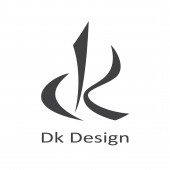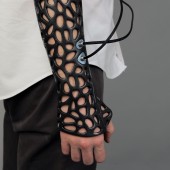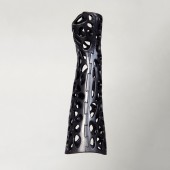DESIGN NAME:
Osteoid
PRIMARY FUNCTION:
Medical cast, attachable bone stimulator
INSPIRATION:
Cancellous (spongy) bone geometry.
UNIQUE PROPERTIES / PROJECT DESCRIPTION:
The goal of this project is to improve the overall healing experience for broken or fractured limbs by focusing on the patient’s comfort and the amount of time needed for the body to heal itself.
Comfort; creating a stable and protective environment. Conventional medical casts sacrifice ventilation for structural integrity. As a result they are itchy, they smell very bad and due to plaster’s material properties they are bulky, heavy and they limit patient’s exposure to water. Osteoid medical cast offers a new way of tackling these problems by introducing new technologies which enables us to make custom fitted, durable 3d printed medical casts that doesn’t itch or smell. Plus due to material properties the end products are slimmer, lighter, doesn’t affect from water and environmentally friendly.
Time; Osteoid medical cast can also be combined with its complimentary, low intensity pulsed ultrasound (LIPUS) bone stimulator system. For single 20 minute daily sessions this system promises to reduce the healing process up to 38% and increase the heal rate up to 80% in non-union fractures. In order to function, the LIPUS ultrasound probes has to be placed on the injured area with direct skin contact, because of this requirement it was not possible to use this method with patients using standard medical casts. Now thanks to the ventilation holes on the Osteoid medical cast the LIPUS bone stimulator probes can be placed over the injured area.
OPERATION / FLOW / INTERACTION:
The LIPUS pulse generator has an on /off button at its side. At the center of this pulse generator there is a color switching led which guides the user about operational state and session time with different colors and blinking patterns.
PROJECT DURATION AND LOCATION:
This project is the outcome of a 4 month study in Izmir Turkey.
FITS BEST INTO CATEGORY:
Medical Devices and Medical Equipment Design
|
PRODUCTION / REALIZATION TECHNOLOGY:
There is a lot of technology involved in the design and production process. In order for the cast to perfectly fit to the patient’s limb, the area is scanned via a 3d body scanner. Then this data is transferred to a modeling software, where the overall size and geometry is decided depending on the medical situation. Later on additional locking mechanism and algorithmically generated ventilation holes are added to the final C.A.D data along with LIPUS probe adapters. Later on these data are 3D printed with FDM from ABS which is widely used even in food containers. Keep in mind that there is a large variety of color options available. In order to keep the design language in tacked the LIPUS bone stimulator system is produced in the same way with a 3D printer.
SPECIFICATIONS / TECHNICAL PROPERTIES:
The size of the medical cast is case sensitive but the dimensions of this particular model is 130 X 108 X 315 mms. The size of the LIPUS bone stimulator system is 130 X 145 X 40 mms. Osteoid medical casts are made from two pieces which can be fixed together like a jigsaw puzzle. There is a central hole passes through the edges of these pieces where a flexible pin is inserted to tightly connect these pieces together. The LIPUS probes are attachable to the Osteoid medical cast. There is a thin layer of rubber fixed to the edges of the LIPUS adapters, this rubber layer helps these pieces to fit on the ventilation holes of the medical cast.
TAGS:
3D print medical cast,
RESEARCH ABSTRACT:
The LIPUS pulse generator and the nature of healing with LIPUS was the primary focus of our literature review we based our concept on the studies of,
Heckman JD, Ryaby JP, McCabe J, Frey JJ, Kilcoyne RF. (1994) Acceleration of Tibial Fracture-Healing by Non-Invasive, Low-Intensity Pulsed Ultrasound. J Bone Joint Surg 79-A (1): 26-34
Siska PA, Gruen GS, Pape HC. External adjuncts to enhance fracture healing: What is the role of ultrasound? Injury. 2008;39:1095–5.
Prior works: Jake Evill: Cortex, http://www.evilldesign.com/cortex Nicholas Solakian, Peter Nguyen, and Derek Buell: Splint, http://www.popsci.com/technology/article
/2013-08/intricate-3-d-printed-exoskelet
on-splints#comments Julian Grote: 3D printed Cast, http://www.juliangrote.com/59817/2013031
/work/3d-printed-cast
CHALLENGE:
The most difficult part was to come up with a fully functioning locking mechanism which is strong enough to protect the limb, practical enough to put it on the fragile injured area and simple enough so that it doesn't disturb the general form of the medical cast.
ADDED DATE:
2014-03-23 12:48:41
TEAM MEMBERS (1) :
Deniz Karasahin
IMAGE CREDITS:
Deniz Karasahin, 2013.
|










